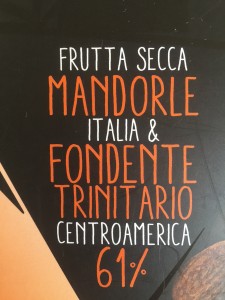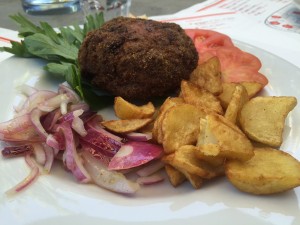Introduction:
Throughout the trip, many have pointed out the unethical treatment some domesticated animals are receiving, and the non-biological methods of growing grapes in many towns outside Panzano. Some of my friends have also decided not to consume such unethical food anymore, and will lean towards choosing ethical products, such as beef from free range and grass fed cows, and wine made from biologically grown grapes.
Yet, in my opinion, labeling food as ethical or unethical is purely a game played by various parties, and by avoiding consuming “unethical” products is never a solution to this problem. This is because almost all of the food we are consuming can be termed as unethical in various ways.

Production:
Production usually come in two categories, labor-intensive and non-labor-intensive.
Non-labor-intensive industries such as mechanized and automatized production of crops have numerous problems, one of them being the replacement of human labors with machineries. Mass production of corn and wheat with the help of state-of-the-art cultivators, sprayers and harvesters has reduced the cost of production, and has been gradually diminishing the role of human workers. Unemployment prevails in countries that have just adapted such methods as automated harvesting. China’s 1.4 billion populations used to consist of more than 1 billion farmers, but now only just slightly more than 200 million as a result of increased efficiency by using machines. Many of them are in a transitional period from the primary industry to secondary industry. In other words, farmers who do not make profits planting crops are trying to make a living in the city. Being semi-skilled, most of them are forced to work in the labor-intensive industries such as electronics assembly line or construction zones. These people are usually labeled as migrant workers, making a population of 270 million in 2015 in China alone. It is not difficult to observe that this whole process of automation and mechanization has led to a shift in labor, making a tiny fraction of the producers happy, and leaving the rest suffer. It may not necessarily take place in Italy, but there certainly are places fit into such description. Saying these food ingredients (those harvested and planted by machines) come from an ethical source? I highly doubt it.
On the other hand, labor-intensive food production processes such as cocoa picking in Central Africa and South America are surely unethical, as workers are underpaid, child labors are involved, and working conditions are just too awful to imagine. An example would be Ivory Coast. During the 2013–2014 harvest season, an estimated of 1.2 million children of age between 5 and 17 worked in the cocoa production, of which 95.9 percent were engaged in hazardous working conditions[1]. During our stay in Toscana, I’ve observed that much of the chocolate we consumed have cocoa produced in such regions as Central Africa and South America, and it is hard to tell whether the cocoa used in gelateria comes from an “ethical” source.

Distribution:
Advertising plays an essential role in the operation of any distributor. TV commercials, event sponsorship and free samples given on streets are all common forms of distributors’ advertisement. However, instead of telling consumers about the ingredients used in manufacturing such products, which should be the primary focus to ensure safe consumption, advertising campaigns often focus on drawing attention from the customers, such as the “Share a coke with”, and “StayExtraordinary” by Coca-Cola in the United States. In Italy, situation is not any better. During my evening stay at a hotel in Castiglione della Pescaia, the TV had more than two hundred channels broadcasting food and snack commercials simultaneously and non-stopping. With limited understanding of Italian language, I could not figure out the exact meaning of these commercials. Yet, I was able to capture words such as “benessimo”(very good) and cartoons aimed to draw children’s attention. These advertisements usually create a falsely presumed sense of product safety among consumers, as consumers may take for granted and think that there is nothing to worry about when drinking coke or eating biscotti. Yet, there are things to worry about. Problems associated with food products such as soft drinks and sweet snacks are the excessive amount of sugar present, and the use of caffeine (in coke). And it is east to tell that they are not really good for a healthy lifestyle. With such advertising campaign taking place almost every day, I believe that this practice, and hence such products, shall not be considered as ethical.
By now, some people may be eager to argue that such advertisement campaign does not apply to all the distributors, and many of them actually highlight information such as chemical content in their commercials and brochures like what we’ve observed in vineyards such as Le Fonti and Nittardi, which gave detailed descriptions about their products and production process. Yet this practice takes place not very often, and it usually takes place only on the early distribution process. When wines, biscotti, and many other food products enter supermarkets, like Mercato della Piazza di San Lorenzo in Florence, there is not much explanation about the food products available on the shelf or even from the shop managers. I could only obtain limited information regarding all the products, and could not figure out which products were the results of an “ethical” production process.
Generally during distribution, products of various qualities are often mixed up, and it is difficult to tell the source, ingredients or production methods associated with the food products from the consumers’ perspective. This is because distributors usually aim at maximizing profits. Creating a competitive price and an appealing image of the food products is their primary goal. Consideration on if these food products are ethical is often left way behind.
Aiming at creating more profits by encouraging people to consume more, yet discarding potential health issues caused by over-consumption and excessive nutrients intake, food distributors should reconsider their advertising strategy, and help consumers to make a healthier choice of diet. As such, I hold the opinion that food distributors with such advertising strategies taking place shall not be considered as ethical distributors, and their products neither.
Consumption:
Imagine a particular food item that miraculously escapes all the criticisms mentioned above. “This must be absolutely ethical,” you might say. However, in my opinion, by passing the last stage, consumption, such ethical food products are not ethical anymore.
Consumers nowadays share one common characteristic. That is their endless demands. If consumers do not like certain products, the products disappear from the market. If consumers like something that was only produced in the 90s, distributers still can get it back, just like the “Bring Back Crystal Pepsi Movement”.
The demand for food products triggered, or partially helped establish, the Silk Road, where the exchange of goods such as spices, fruits, and grains took place in between Asia and Europe. Till now, we could still find traces of evidence such as mulberry trees (leaves are used to feed silkworms) planted in the Chianti region. As technology advances, people found out that automation could reduce the cost of products and thereby making products more affordable. So the industrial revolution came. Massive automated assembly lines such as those of Barilla took over the roles of workers. Only a tiny fraction of the food manufacturers could maintain a small-scale profitable production process. Repeatedly raising a demand and meeting the demand goes on till today. In general, consumers help shape today’s world.
Yet, this endless demand for better, more varied and cheaper food products has led to a chain of actions that harm producers, distributors and consumers themselves. When consumers say, “We want affordable beef”. Distributors say yes in order to meet the demands of the consumers. Distributors then turn to producers who raise cows, and proba
bly will tell them that the buying price has dropped. Producers, in order to maintain profitable, will often change the way cows are raised. A common practice would be feeding cows with corn, and keeping them in tiny sheds to minimize land use, hence reducing the cost. Some farmers may not have the means to raise cows in such way, and they may go bankrupt eventually. In the end, large “factories” take over, as large scale of production usually leads to small marginal cost, and hence could cater to the needs of the consumers. Yet, back to consumers, nowadays only a few of us choose to accept higher price grass fed beef, and most of us go with corned beef. This creates a vicious cycle that traps the consumers, distributors and the producers. This cycle is also the reason why Dario Cecchini’s project Chianina di Lunga Vita is a only luxury for the rich.

Conclusion:
After observing the whole cycle of food production, distribution and consumption, I believe that consumers are the true source of evil. As our endless demands keep going, producing healthy, organic and harmless food products seems to be an insurmountable quest. And at the end of the chain, greedy consumers who want cheaper products are killing the future of healthy food production, and as long as we still demand our food ingredients to be cheaper than it is today, there is simply no room for discussing what is ethical or unethical, because consumers’ actions and involvements in the food production and distribution cycle are not ethical in the first place. Furthermore, any products that come out to fulfill the demand of consumers, which help consumers fuel and propel all the unethical actions in the stages of production and distribution, should not be considered as ethical. And that means all the food we have on our plate today.
Yet, I believe that as consumers, there are things we can do on a personal level even though it may not necessarily alter the well established and the seemingly unshakable food production and consumption cycle. I believe that the least we can do is showing respect to the food we have today. When we have a plate of beef stew in front us, regardless whether the cow went through ethical or unethical treatment in its life, it is our chance and final chance to show it respect.
We need to keep in mind about the effort put in by farmers, butchers, cooks and waiters, a group of people who make this dish possible in the first place. It is never about whether we like it or not. It is also not about the flavor or the texture of the dish on an objective point of view. We need to show respect, and eat or drink it without necessarily feeling elated or disgusted by the dish like many people are doing today. Respect is key. And eating while paying respect, in my opinion, is one of the few ways to consume our food “ethically”.
[1] United States Department of Labor, 2014 Findings on the Worst Forms of Child Labor, 2014, http://www.dol.gov/ilab/reports/child-labor/cote_divoire.htm
